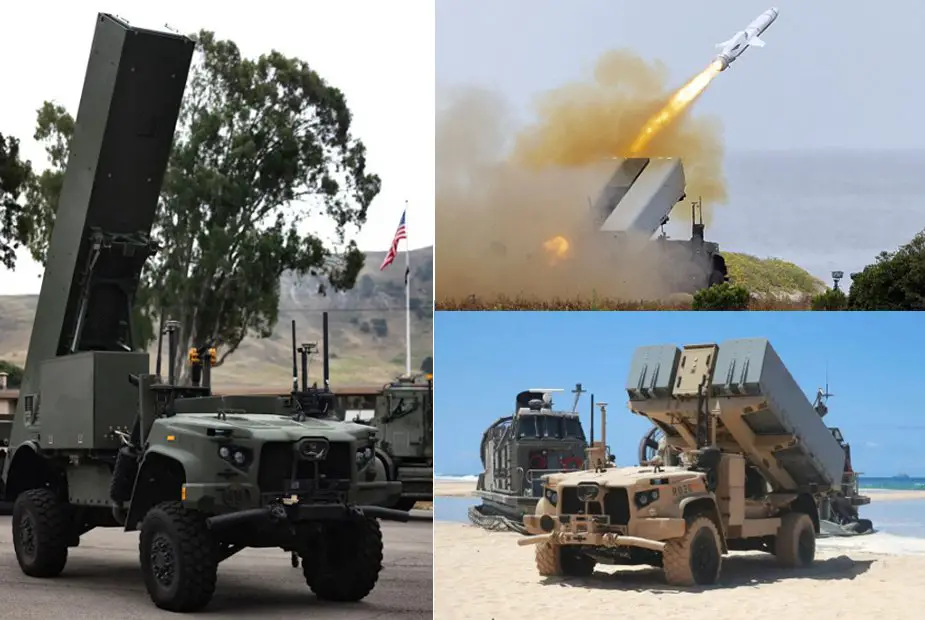According to an article published by the U.S. Naval Institute on July 25, 2023, the US Marine Corps has publicly disclosed its most recent unmanned 4x4 launcher vehicle, designated as the Long Range Fires Launcher (LRFL), at the core of the new ground-based Tomahawk cruise missile unit. The LRFL was unveiled during the official ceremony commemorating the establishment of Battery A, 11th Marines, at Camp Pendleton in California on July 21, 2023.
Follow Army Recognition on Google News at this link

The new Long Range Fires Launcher will join the NMESIS as ground-based Tomahawk launchers (Picture source: US Marine Corps)
Being the inaugural unit equipped with LRFLs, Battery A's activation marks a notable advancement in the Marine Corps' quest for enhanced firepower and operational adaptability. Battery A, serving as the Marine Corps' primary Long Range Missile (LMSL) battery, was formally activated earlier this year.
The LRFL forms part of the Remotely Operated Ground Unit for Expeditionary-Fires (ROGUE-Fires) program, which involves the use of an unmanned 4x4 JLTV operated remotely by ground personnel. The deployment and performance of the LRFL will be closely monitored to evaluate its capabilities and impact on future Marine Corps operations. The Marine Corps has outlined its future plans for the LRFL, intending to establish a multi-battery LMSL battalion equipped with several launchers by 2030.
Distinguishing itself from the earlier design based on the Joint Light Tactical Vehicle (JLTV) firing the Naval Strike Missile (NSM), also known as the Navy Marine Expeditionary Ship Interdiction System (NMESIS), the LRFL appears to have the ability to load only one Tomahawk at a time, unlike NMESIS, which can carry two ready-to-fire NSMs simultaneously. Additionally, the LRFL showcases distinct boxes on both sides of the chassis, the exact purpose of which remains undisclosed but could potentially house specialized Tomahawk-specific systems, including advanced fire control hardware. The LRFL and NMESIS systems are part of a broader joint service long-range land-based strike ecosystem, aligning with the military's efforts to bolster long-range strike capabilities for potential future conflicts.
Pictures of the LRFL have provided insights into its configuration. The length of the Tomahawk missile canister on the LRFL suggests that it might protrude beyond the vehicle's rear and possibly front when stowed for travel, addressing previous concerns about the vehicle's center of gravity. The relatively compact size of the LRFL offers potential advantages in terms of transportability compared to other systems used by the U.S. Army and Navy for launching Tomahawks and other missiles. Furthermore, the Long Range Fires Launcher features distinct 'boxes' on either side of the center of the chassis, which are not present on the NMESIS. The exact purpose of these boxes is not immediately clear, but they could contain a variety of Tomahawk-specific systems, including fire control hardware.
While many details about the LRFL and NMESIS remain undisclosed, the Marine Corps envisions them as vital components of their ground-based anti-ship missile development strategy, with the anti-ship optimized Maritime Strike Tomahawk (MST) being the primary armament for LMSL units.
The Tomahawk missile is a long-range, subsonic cruise missile developed by the United States. Renowned for its precision and all-weather capabilities, the missile can strike targets with high accuracy from hundreds of miles away. Its guidance system employs Terrain Contour Matching (TERCOM) and Digital Scene Matching Area Correlation (DSMAC) technologies, enabling it to navigate and adjust its trajectory during flight for improved targeting. Armed with conventional warheads, the Tomahawk serves various mission profiles, including land-attack and anti-ship operations. Its launch platforms include surface ships and submarines, providing strategic flexibility to the military. Over the years, the Tomahawk has been extensively employed in conflicts worldwide, showcasing its effectiveness in engagements such as the Gulf War and subsequent conflicts in Iraq, Afghanistan, and Syria.















